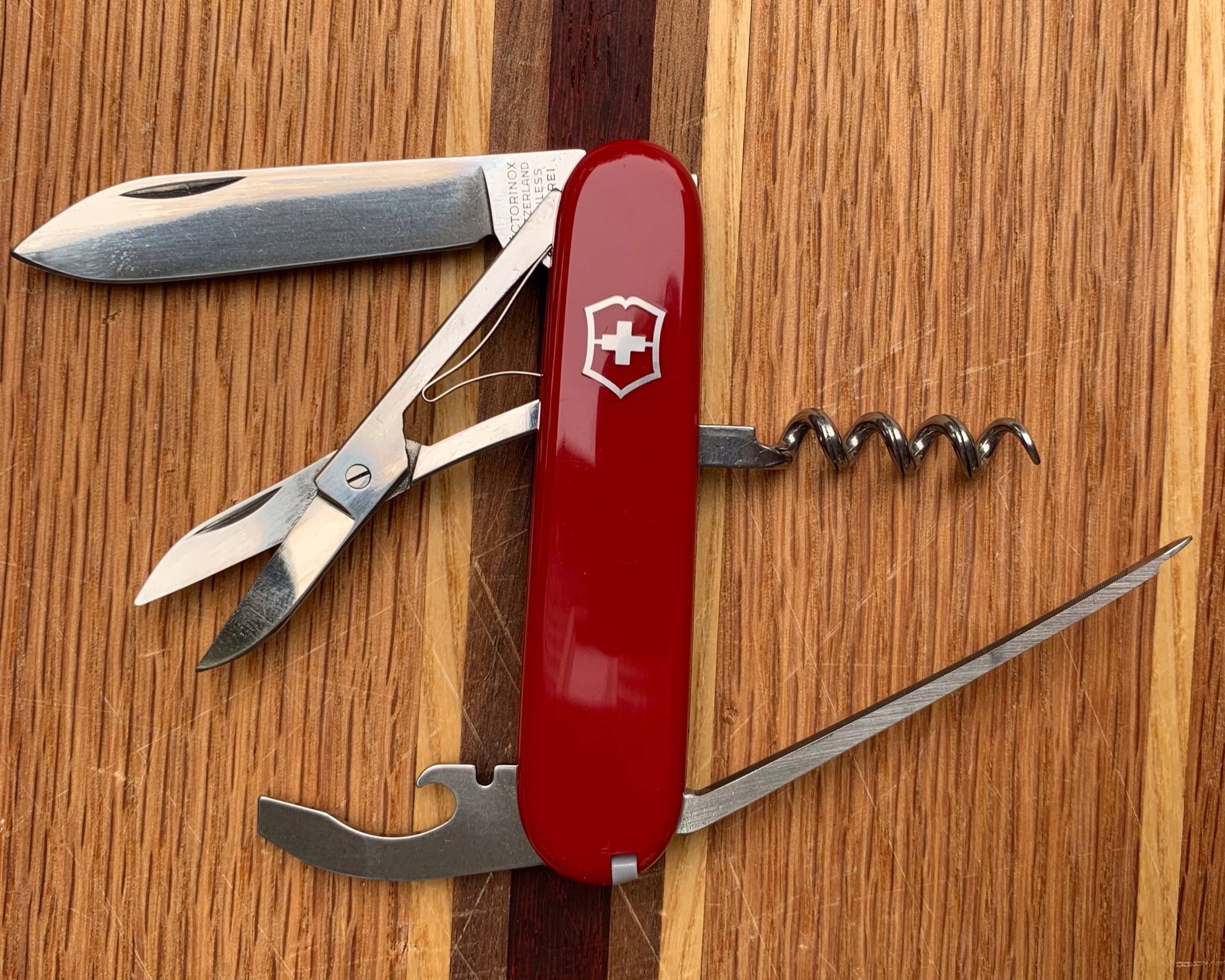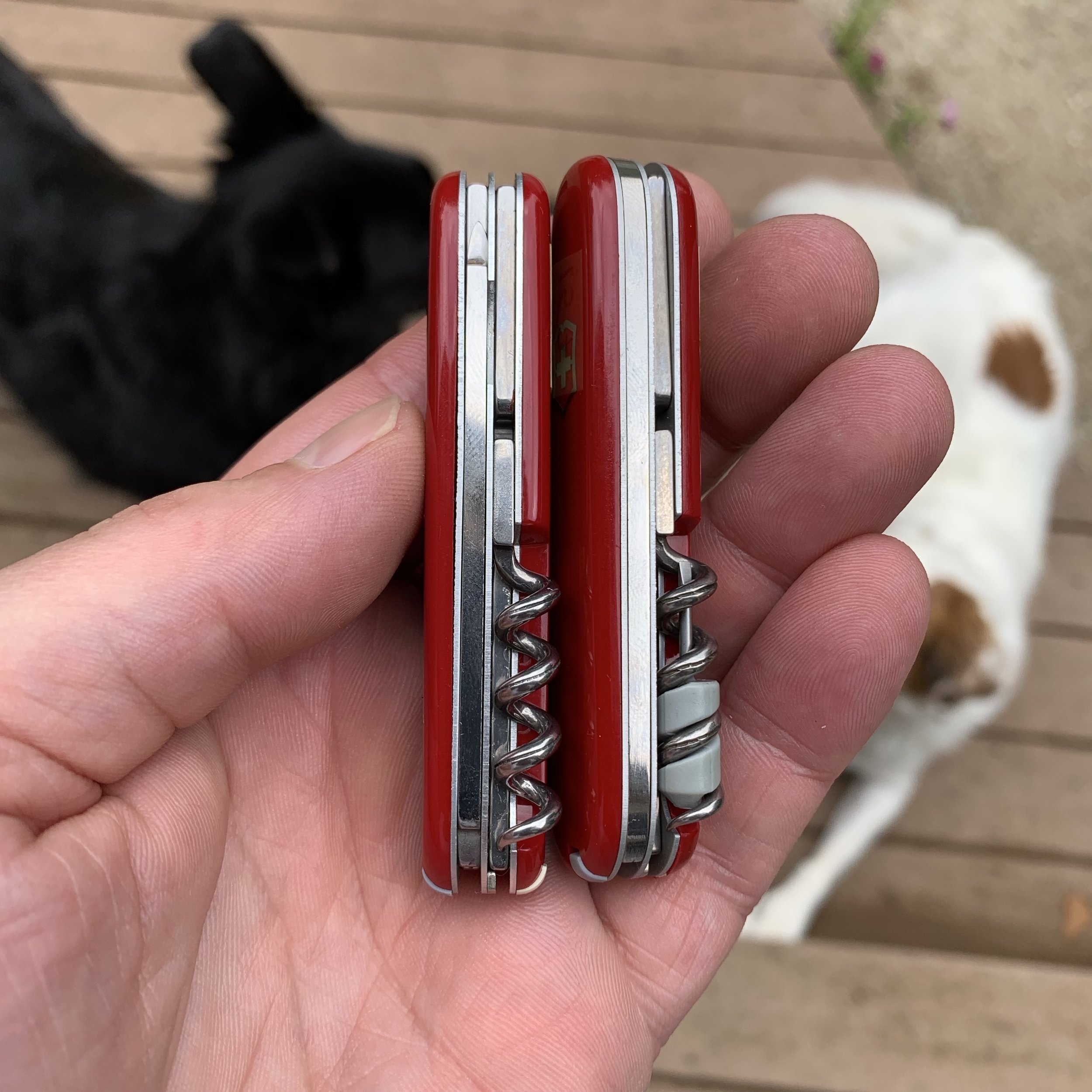Summer reflections. A new dog and a few new SAKs.
Myron Erickson
One season ends, another begins.
Summer 2019 is over, and once again I find myself wondering where another summer has gone. In my case, I enjoyed a lot of beaching and swimming in northern Michigan, my fair share of Two Hearted Ale, a little canoeing, a lot of mountain biking, and a happily project-free Land Rover season. In late August we moved our kiddo into the dormitory to begin his own Adventures in Engineering School, and then we finished the summer and welcomed the fall by bringing home a new dog, Annie, to join our Juniper on the first day of autumn, September 21.
A summer collage. Top: amazing northern Michigan, Juniper and Annie. Middle: how to carry a bike in a roofless Rover, the Best Beer In The World. Bottom: Annie gets a Red Wing Oro Russet dog collar, Black Bay gets a new strap.
I haven’t bought a watch since March, which is the longest I’ve gone in 10 years. Regular readers will no doubt have noticed a lack of watch-related posts, and the complete truth is that like a bachelor who has sewn his wild oats, I have met The One, and finally settled down. The watch that has won my heart for all time? The amazing Rolex Explorer ref 214270. I’m preparing a Year-On-The-Wrist review of this amazing watch, so for now, dear readers, please be satisfied with a picture.
Two mid-century icons of Swiss design. Timeless marriage of form and function.
I also decided to change the Rover Haven business model, but only after long thought and great deliberation. I’ve had incredible fun custom-building unique straps for unique people over the last seven years, and the greatest reward of this system is the happy customer who is thrilled with a new strap made just for them. It engenders new friendships and is its own advertising, but it also takes a lot of time, time that I no longer have. So starting in the fall of 2019, I’ll be switching Rover Haven over to a pre-made-only mode. I hope my long-time repeat customers will forgive me, but my time is needed elsewhere these days. So keep a lookout for some sweet ready-to-go straps from Rover Haven this fall and please don’t hesitate to reach out if one of them strikes your fancy.
I did pick up a few Swiss Army Knives this summer, some special, some not-so-special but still very fun. So just to get some cool pictures into this post, here’s a quick rundown. Maybe some of these will spark a SAK quest of your own.
Soldier’s Knife, 1891 LE.
In 2009 Victorinox celebrated its 125th anniversary with a slew of special products. Without a doubt the coolest of these was a re-issue of sorts of their original soldier’s knife from 1891. I wanted one when they came out but couldn’t afford the $500 price tag at the time. You’ll see these on eBay today with very optimistic buy-it-now prices, but if you can find one listed privately (or actually being auctioned as opposed to just hawked at great profit), they will fetch very near to their original price.
The wooden scales on the Soldier’s Knife 1891 LE have a warmth and charm all their own.
If you’re interested in early vintage SAKs but don’t have the expertise to make a good selection, or perhaps are turned off by carbon steel, worn springs, bodged implements, or dodgy repairs, this is the knife for you. These are large knives, much bigger than the Model 1961 that became standard Swiss issue starting in 1962 and its identical sibling, the Pioneer. The quality is first-rate, and the special packaging is also worthy of the knife’s significance. I don’t collect watches, firearms, wine, art, or anything else from the late 19th century, so this knife is what takes me back in time and gives one small inkling of what things from that era were like. The soldier’s knife wasn’t a weapon, it was a multitool, and this limited edition really showcases Elsener’s original genius.
Victorinox even recreated the historical tang stamp, showing the knife making family’s name and canton.
1957 Pioneer.
The first Pioneers featured a beautiful round-shanked awl, and the back scale of the knife utilized a cut-out to accommodate it. After only four years, the design of the awl was changed, allowing the scale to be the much simpler mirror image of the top scale with no cut-out, and in turn for production to be simplified and vastly stepped up. A good thing, since this model became the standard issue Swiss soldier’s knife starting in 1962. Without intending to, Victorinox had created a future collectible since the cut-out Pioneer was only produced from 1957 to 1961, and as such is quite rare on its own.
The 1957 Pioneer. Note the round awl and cut away scale to accommodate it. The bail is original and correct.
Finding one that hasn’t been ground down, over-sharpened, left in a wet, salty tackle box, or just plain used up is very difficult these days. I stumbled across this one thanks only to the grace of the SAK gods, and couldn’t believe it when it was mine for a very reasonable price. I wrote a two-part post on the design perfection of the original Pioneer, and at the time I didn’t think I’d ever even see one of these, much less obtain one. This one is in very nice shape, respectfully employed in its life but still ready to offer decades of further service. A real gem in my collection.
Note the cap lifter implement’s ground scraper edge and wire bending notch. +PAT on the can opener adds charm.
Rover Haven Tinker.
A Tinker, in the full 91 mm frame size, was the second SAK I ever bought for myself way back in the day. And for Father’s Day this summer my own kiddo recaptured my youth with this Rover Haven engraved black specimen. Such a special gift for me.
I filed off the keyring attachment point on my old high school Tinker decades ago. Note the can key feature on its Phillip’s head screwdriver.
The differences between the two are subtle: the tang stamps, the can key slot on the Phillips head, and if you took the scales off you’d find the inside surfaces different. Think about the industrial product designs that have lasted this long on the market relatively unchanged — the Omega Speedmaster Pro, the Browning A-5, the Land Rover utility models — all of them iconic.
“Alpineer” Passenger.
In my last post about SAKs I highlighted two knives from the three in the First Canada Series. I originally wrote that I was still looking for the Passenger with Alpineer inlay, but a few months later I lucked across one. It’s a user/carrier, but I couldn’t be happier with it. Now my collection of this series is complete.
The First Canada Series of VSAKs. Would that Victorinox still made detailed inlays like this today.
Keyring Soldier.
In the second of my two-part post on the Pioneer/Soldier/Model 1961, I briefly mentioned the rarity of the Soldier that came from the factory with a keyring attachment. Conventional wisdom holds that the Model 1961 was never issued with a keyring or bail. If you read that post, you’ll understand that this SAK was made with the ability to accept a bail or lanyard for a few very specific purposes, until eventually even that functionality was dropped when the 6th generation of soldier’s SAK appeared in 1993. Surplus Victorinox Model 1961’s sold on the retail market as the Soldier never offered a bail or keyring, although surplus Wenger Model 1961’s sold as the Standard Issue always had a bail added to them. Of course, the Pioneer was sold at various times and in various versions and editions with a bail, a keyring, and without bail or keyring.
What the…? A Soldier with a keyring?
However, all that said, it turns out that Victorinox did indeed produce a few true Model 1961’s that were sold as Soldiers with a keyring attachment in the late 1990’s. It may be that these were produced for one particular Canadian retailer, but the picture is far from clear and their numbers are very limited. If you want a really unique SAK with the features and provenance of a true Model 1961 and the added utility of the Pioneer’s keyring attachment point, you should seek one of these out. To the trained eye, it’s a rare oddity at best and a contradiction at worst. Like a classic Saab 900 with an automatic, or one of those hairless cats like Mr. Bigglesworth after he escapes into orbit with Dr. Evil.
What few keyring Soldiers I’ve seen all date to the late 1990’s.
Old Cross Farmer.
The Victorinox Farmer is my favorite weekend pocket knife. Particularly if you are traveling by car, or camping, or doing yard work, or just hanging out on your deck, it is a dynamite little package of utility in your pocket. Earlier this summer I decided spontaneously to convert an older wooden deck chair into a side table. Out came the Farmer and 60 seconds later I had sawed off its back and turned the seat and legs portion into a nice little table. Of course, the Farmer is just a Pioneer with the addition of Victorinox’s brilliant wood saw, but its utility somehow exceeds the sum of its parts.
It’s easy enough if you want a Farmer for yourself, because it’s still in Victorinox’s current catalog. Just go to Victorinox’s website and order one; it’ll cost you all of 43 bucks. But if you have an eye for special style, or color, or classic design, you might want to spend a little more time and find an earlier “Old Cross” model. These were produced right through the 1990’s, so they’re really not all that rare. But they’re just so flipping cool that the extra effort is worth your time. Expect to spend about $75-$100 on a nice one; anything less is a steal.
Golfer with long nail file (LNF).
The 84 mm Golfer with long nail file. The end of the implement is a nail cleaner and the underside has a file surface.
Regular readers will know that one of my all-time favorite Victorinox SAKs is the 84 mm Golfer, seen below. Long discontinued as a model, its combination of tools (knife blade, combo opener, and scissors) makes up what I call the 95% toolset because it handles about 95% of what I would ever need a pocket knife to do. The Alox-scaled Voyageur shares its frame size and tool load, but the Golfer adds a corkscrew. For wine drinkers this surely comes in handy, but it also offers a storage place for the mini-screwdriver.
The regular 84 mm Golfer.
I bought a regular Golfer brand new at a shop in Switzerland in 1988, a lucky thing since it was discontinued by Victorinox shortly thereafter. In recent years I’ve bought several used specimens as donors of the long-extinct 84 mm scissors or as users to carry, given a few away to family members, and saved one or two as shelf queens. A good used specimen will set you back $60-$70, although I’ve seen the odd poorly listed example go for $40-$45. My own rule of thumb: if I see one for under 50 bucks, I jump.
LNF Golfer on left. Note the differences in combo opener profile and overall architecture, which can be seen plainly. It is very unusual to have the scissors and knife blade sharing a pivot on a VSAK. In fact, I can’t think of any other examples.
However, although I knew Victorinox had offered the Golfer with a long nail file, I had never even seen one for sale new or used. This unusual Victorinox implement was supplied on only some Golfers, but by far the vast majority of these little SAKs that you’ll see today do not have the long nail file. So when I saw an über-rare new old stock specimen on that large auction site, you can imagine my excitement. I hesitated for a couple days, waiting for some other collector to buy it and put me out of my misery, but subconsciously hoping they wouldn’t. The little Golfer was priced shrewdly and after two days of this misery, I finally caved; I simply had to have it. Mine came with its original box and owner’s manual, veritable SAK collecting nirvana.
From the back, the long nail file (L) is very subtle, almost indistinguishable from the regular model (R).
I will probably never carry or use this LNF Golfer. For one thing, it’s a mint-in-box specimen and its value would go down with use. For another, the long nail file pivots on a tiny pin that is only secured into the liners, not the larger pin that the combo tool pivots on and that holds the whole knife together. It is therefore a somewhat fragile arrangement, which may also explain why you see so few these days. The value in owning a thing like this is in studying it, sharing knowledge and observations about it, and caring for it as an artifact of SAK history.
This concludes my what-I-did-over-summer-vacation post. As always I welcome your comments and corrections and thank you for reading my blog.















